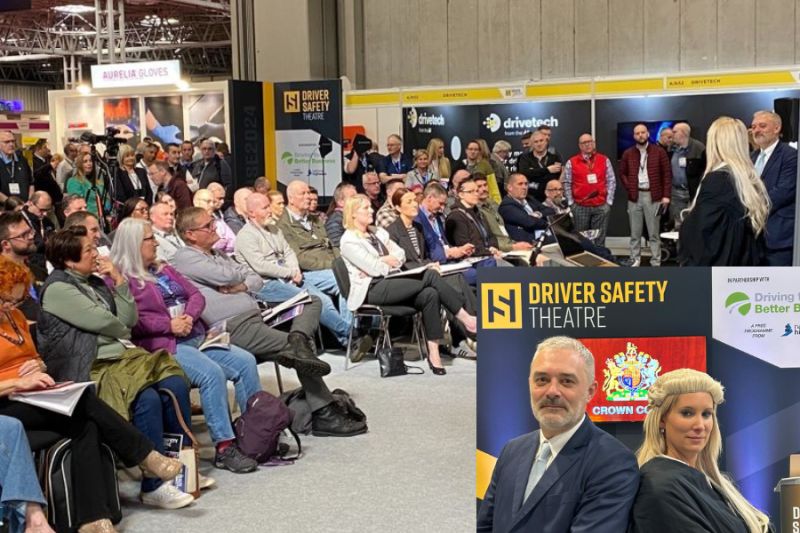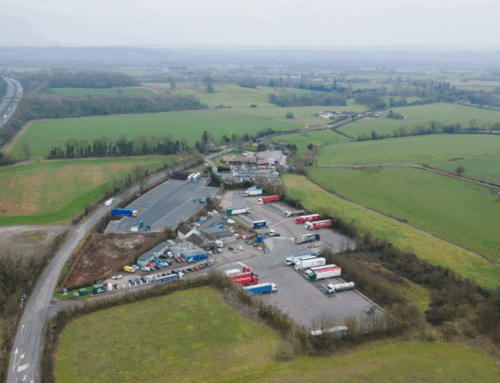Does your organisation need a driving for work policy?
This year, thousands of health and safety experts visited The Health & Safety Event – the UK’s largest gathering of those responsible for running a safe and efficient workplace. One of the major draws at the event was our Driver Safety Theatre, where the question, ‘Why your organisation needs a driving for work policy‘ was about to be answered.
The minute the doors opened, hundreds made their way straight to the Driving for Better Business stand and Driver Safety Zone to secure a seat at the show’s hottest ticket: The Mock Trial.
This is where they came to learn about their biggest work-place risk: driving for work.
The Mock Trial is an eye-opening walk-through of a serious road incident.
It features Bob Adams, a van driver who begins his day’s work schedule a bit tired, slightly over the limit from the night before, but ready for the day ahead. The combination of factors then result in a serious incident involving a cyclist, as Bob was en route to his first stop. The police are called to the scene.
As well as having alcohol in his system, the driver was taking a call – handheld – on his mobile at the time, as his Bluetooth connection wasn’t working, and the van is found to have dangerously worn tyres. The driver pleads guilty. The audience unanimously agrees with the guilty verdict.
Who’s to blame – the employer or the driver?
But it didn’t stop there. The incident investigation found that the company had serious questions to answer about its driver safety management systems and so The Mock Trial saw the company’s Health and Safety Manager in court, having to defend the company’s driver management systems and record keeping, in the face of challenging questions from our prosecuting barrister, Charlotte Le Maire of LMP Legal.
The presentation examined what went wrong, why it went wrong, and what a subsequent investigation and prosecution could look like. Most importantly, it looked at what companies should be doing to avoid a similar scenario happening to them.
In this instance the driver did not carry out basic daily vehicle checks, so the worn tyres went overlooked. But the fleet safety manager, who would have seen the MoT advisory note to replace them, failed to factor in the wear that would be anticipated with the high mileage typical of the company’s van drivers.
How can an organisation prove compliance?
When asked to present evidence of daily vehicle safety checks, none could be produced, and the company’s driving for work policy was found to be little more than an 8-point wish-list.
After much more detailed examination, the company’s systems are deemed inadequate and the company found guilty of breaching sections 2 and 3 of the Health and Safety at Work Act 1974.
At sentencing the audience were shown how fines are calculated based on the company’s turnover, not on its profit.
Bigger organisations with a turnover of more than £50m now face fines of up to £10m; medium-sized organisations with £10m-50m turnover face up to £4m in fines; small organisations with £2m-10m turnover face up to £1.6m in fines; and micro-businesses with less than £2m turnover face up to £450k in fines.
In the Mock Trial, the company had an estimated turnover of £11-12m putting it just into the medium category, and the guilty verdict and fine of £1.2m could be heavy enough to finish the business financially.
What does a good practice driving for work policy template look like?
Over the three days of The Health and Safety Event, Driving for Better Business helped health and safety professionals understand the common weaknesses of many organisations whose employees use vehicles for their job and, most importantly, how to create a driving for work policy.
The driving at work online policy builder is a vital tool for achieving legal compliance, building a safe driving culture, and setting out the standards expected of your drivers.
Simon Turner, campaign manager for Driving for Better Business, went on to demonstrate the online resource that employers can use for free to write, review and update a good practice driving for work policy for their workforce.
The template guides users through everything they need, and by signing up, they will receive updates and reminders to keep the policy current.
Motivating and Managing Drivers
The next session in the Driver Safety Zone was a panel discussion about motivating and managing drivers, with experts from Flagship Partners, Northern Powergrid and City Building Engineering Services talking about the process of building a safe driving culture and motivating staff towards a safe driving-related goal and vision. The group looked at the importance of policy, management processes, leadership, expectations, training and monitoring, compliance and progress.
Dr Lisa Dorn, professor of Driver Behaviour at Cranfield University and Karl Wilshaw, Fleet Director at Travis Perkins then outlined a project that identified three major areas to focus on to improve driver safety. Travis Perkins are now using these findings to guide their driver safety strategy, including policies, driver training intervention, recruitment and driver wellbeing.
Where do employers fail?
On day two, Charlotte Le Maire, Specialist Criminal & Road Regulatory Lawyer, who also led the Mock Trial, then took visitors through a Q&A, outlining some of the key areas where employers often fail to meet their obligations. She reviewed how this can impact risk management within the company – and the ability to offer a credible defence in the event of a serious incident.
An expert panel, with leaders from the Health and Safety Executive, Diabetes Safety Organisation and Randox Testing talked about the importance of driver fatigue, diet and nutrition, job stress and personal lives – all of which present common distractions among your drivers – and how to manage these factors in your own workforce.
Senior leaders from National Highways, the Rail Safety and Standards Board, and civil engineering company FM Conway focused on the need for authentic top-down leadership as part of the driver safety culture, and on using the tendering process to raise standards among suppliers.
Internal investigations – serious driving at work incidents
The final day saw a repeat of the Mock Trial – as busy as the previous two days. This moved on to the internal investigation a company would be expected to conduct following a serious incident, led by collision investigation expert, Andrew Drewary.
Taking the trial scenario as an example, he looked at the failures of management that could have contributed to the to the crash, how it could have been avoided, and how to act on findings.
If you were unable to attend, missed some crucial sessions, or liked what you saw and want to share it with colleagues, you can sign up for the videos of all presentations here.






